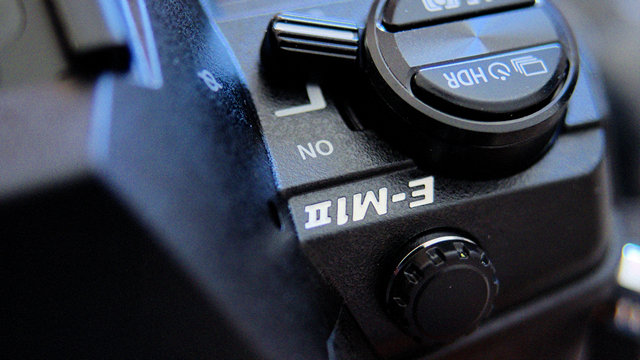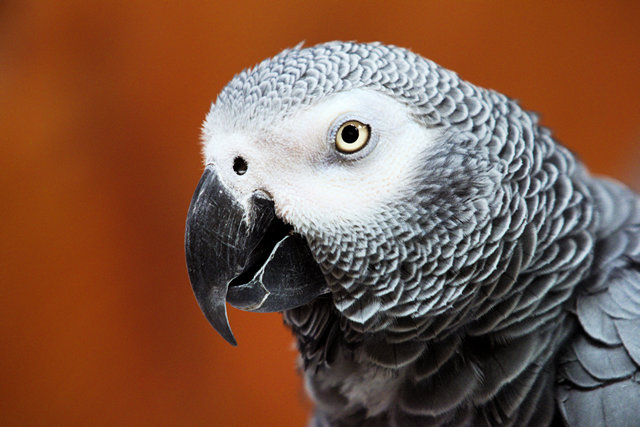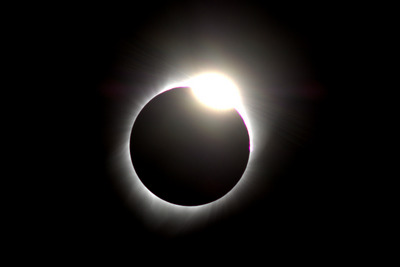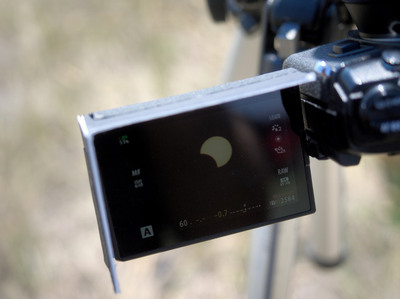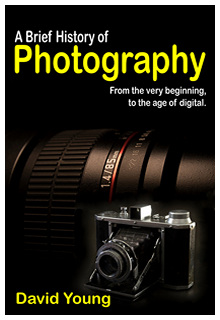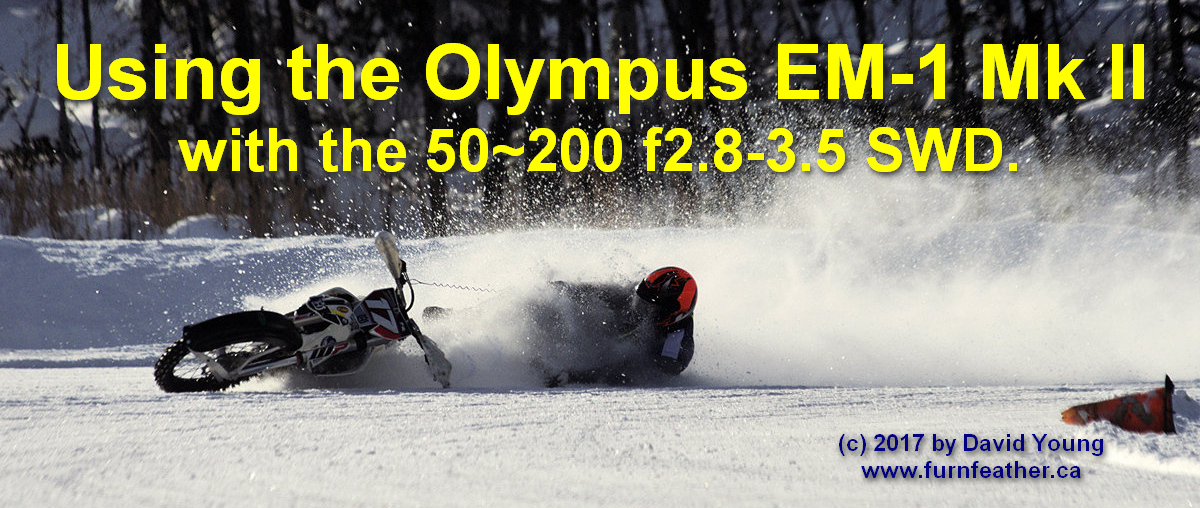 Background: This review, like most, is simply one man's opinion. I've often been asked "what qualifies you to judge a camera?" Well, in my case, I've
been behind a camera since the early 1960's, taking photos in some 29
countries. (My photos grace walls
from the Ukraine, to Abu Dhabi, to Tasmania. You can check them out,
here.) I've been a
guest speaker & presenter at photographer's coventions
in Germany and across the USA, as well as in my native Canada.
I've taught
photography from Rochester, NY to San Francisco and have
judged both
the
"National Nature" and
"National Open" competitions for CAPA
(the
Canadian Assoc. for Photographic Art). I have served on
the Board of the International Leica Society, published the popular e-book, "A Brief History of
Photography" and, back in 2006, was a
pre-production tester-reviewer for Leica's first digital
camera, their M8. 'Nuff
said.
Now, as I get older, I find that large, heavy cameras are becoming "a pain in the patoot" (which is, I understand, right between the delicatessen and the safety zone). I wanted something small, light, and easy to carry when I travel. But, as a semi-professional photographer, results still have to be top tier. So, after six and a half years with the E3, I moved to the Olympus E-M1, and just recently, to the E-M1 Mk II. I've had the E-M1 Mk II for about 3 months and I must admit, I love it! It truly is everthing I'd hoped the original E-M1 would be. So, What makes it different? Well, a host of things. from the obvious, to the not so obvious. From the 121 cross-point, on-sensor Phase Detection AF, the new, much improved battery indicator, the larger, longer lasting battery, to the simple act of placing the tripod socket under the center of the lens. The computer upon which I am typing this report used to have a dual-CPU (these days, called "dual-core") processor. Recently, I upgaded the CPU to a Quad-core one, and the improvement in speed was quite remarkable. I ran a test program and the time it took dropped from 188 seconds to 73 seconds. The Mark II is seriously over-engineered, and has two (count 'em, 2) Quad-Core processors in it ... one for AF and the other for everything else. It makes this camera seriously fast.
Very nice. Other tiny improvements are that the tripod socket is now under the optical axis of the lens, whereas the Mk I was somewhat off center. For most things, that did not make a great difference, but making critical panorama shots, it made things a wee bit more difficult. Problem solved, with the Mk II ! What's not to like? Well, a couple of things... One thing I don't care for is the fuly articulated sreen. My old E3 had the same feature. While it worked well and never gave me any grief, I was always afraid it would break. It just doesn't feel solid. The flip down/up screen of the Mark I is more suited to still photographers, while I gather that the video guys & gals love the fully articulated version. (Frankly, the video function on my cameras could be broken, and I'd never know!) With the flip down screen of the Mk I, it's an almost instant reaction, if I want to hold the camera down, for a low angle shot (such as a cat, kid or something artistic). With the fully articulated screen, I have to find the little indent, bring the screen out to the side and then turn the screen over, before I can see it from behind the camera. Too many steps and the shot if often gone before I can get it done. :-( More importantly, I've used the flip-down screen for serrupticious street shotting, on subway cars, etc. You can flip-down the screen, hold the camera in your lap and never be noticed. Especially if you're using the electronic shutter. If you have to bring the screen out to the side, you suddenly become very noticeable.
I'd be delighted if Olympus made the camera in two versions - much as Sony does with their A7s and A7r. One would have all the video software, microphones, etc., and the fold out screen for videographers, the other without them and the flip down screen, for still photographers. The EM-1 and EM-1v, perhaps! I'm not asking for the flip down version to be at a lower price (although it would be a wee bit cheaper for Olympus to build and a lower price would be nice); just that it be available. The second bugaboo, for me, is the exposure bracketing. I do a fair amount of documentary work - traipsing around after groups of visiting VIPs. If I want to take a series of, say, three shots, with one +1 stop, another -1 stop and the third at the correct exposure, why do you have to press the button three times? Both cameras require it, even in silent shutter mode! Now, I will give Olympus their due. If the Mark II is set to "motor drive" and bracketing, the new camera will take the three shots and stop. That, in itself is a big improvement over the Mark I. The first E-M1 simply takes many shots at the first bracketing setting and then, when the button is pressed again, takes another series at -1 and when the button is pressed the third time, at +1 (or whaever +/- setting has been chosen). Even with the Mark II's improvement, it is often too cumbersome and time consuming to make both those changes, while running after a group of 20 people. It would be nice if, when bracketing is set, that the camera automatically switched to high-speed shooting and took the three shots with one press of the button. It's a small thing, that only a pro would want ... but since Olympus is telling us they're going after the pro market ... Olympus, are you listening? Pro Capture mode is really nice ... especially for things like horse jumping, where only an experienced pro is going to be able to anticipate that "perfect moment". Your press the shutter release half way and the camera starts buffering a series of 14 images, via the electronic shutter. So, when you see that "magic moment" and press the button the rest of the way, if your reflexes were not quite as fast as you'd hoped, you'll still have a second or so's worth of images before that point, to pick from! Brilliant! I can understand Olympus wanting to restrict it's use in to mFT lenses in order to boost lens sales. Olympus claim that they need to control the aperture to do this, but that claim makes no sense to me. I can see no reason why it should not work with even manual focus / manual aperture lenses. Still, even if they don't want 3rd party lenses to work with it, I still think the older, Four-Thirds lenses should! The way it is, it leaves a bitter taste among those who have supported Olympus for many years. Olympus, are you Listening? The last thing that bugs me is the viewfinder blackout during high speed shooting. At max, it's pretty good. At half speed, it should be better, because the shutter is operating only a fraction of the time. But, it appears that the firmware in the camera is a simple "toggle", and at low speeds the viewfinder blacks out far more than necessary. While not horrid, it does make tracking moving objects a fair harder. This should be easily fixed in a firmware upgrade. Again... Olympus! Are you listening? But these are just about the only things that I can think of that I do not like. And there is a great deal to like in the Mark II. The non-issue... Sensor size. Yes, yes, I know. A larger pixel gathers more light, requires less amplifcation and thus produces less noise. So, if two sensors with the same number of pixels are different sizes, it stands to reason that the larger one will have larger pixels. Today's electronics are improved to the point where I will happily shoot the EM-1 Mark II, at ISO 1600 for commercial work and ISO3200 in a pinch - such as in a fairly dark mine or processing mill. For those pixel peepers who worry about such things, let me put it in perspective. I shoot, professionally, with my EM-1s (both Mk I & Mk II) and charge my clients $1000 per day, plus expenses. My clients love the images I get and hire me, repeatedly. "Nuff said. But, how does it work in the real word? Most of the things above, and much more, have been covered by other reviewers. Other than the things noted above, the two cameras are like peas in a pod, to look at and to handle. The real difference is in how they perform. And in that, they are worlds apart! I've had my Mark II about 3 months now, and have watched many a reviewer wax elequent about how good the tracking focus is in the Mk II, compared to the original. And to test them, they show people on bicycles. BICYCLES! C'mon guys, even the MK I would do a bicycle! I wanted to give the Mark II a real test. And, in my neighbourhood, in winter, that means ice racing. These are the guys and gals who race motocross bikes on frozen lakes, at -20 to -25C (that's -4 to -13F in the USA) at up to 130 kilometers per hour (~80 Mph). I think they're nuts, but they're fun to watch! And a real challenge to photograph. After all, subjects coming almost straight at you are extremely difficult for any camera's AF system of sort out. The other half of this test is the freeze-proofing. Olympus rate it down to -10C (-20C for storage purposes only). I shot days worth of photos, at anywhere from -20 to -25 operating temperatures - one day it was closer to -28C. The battery held up very well, and the camera worked perfectly. Because I had ony one battery at the time (replacements are scarce at the early days, as they were with the original E-M1 and, so far, 3rd party batteries are non-existent) I had to retreat two or three times, over the course of the day, to my car. There I removed the battery and held it up against the warm air vent in the dash, until it warmed up. After that, it would work fine. Two batteries, with one always in an inside pocket, should do it. But the camera, itself, never posed a problem, despite the very cold temperatures. So, what did I find? Well, the tracking has an awful tendency to jump around. It picks it's own target, not the target you want. This is inherited from the Mk I and in my opinion was one of the great downfalls of the Mk I. (To my mind, tracking should pick up whatever the small focus point you've chosen is over and stick with it.) And, when you shoot a series of shots, the tracking can lose track of where it is and will often jump to something else - usually the background. Now, to be fair, the other action events I photograph are Rodeos, though their season is not quite here, yet. I suspect that the tracking might do very well on these quick moving ponies and bulls - sorta like how the camera tracks a bicycle! After all, neither a bike or a bull is as fast as a motocross bike. For the boys on the bikes, the solution was to choose a 3x3 square block, and let the tracking pick what it liked within that limited area, as the smaller area is easy to keep over the bike. Used this way, in single shot tracking mode, it almost never failed, despite the high speed of the bikes. One Tiny Quirk... One problem with the 75mm 1.8 Premium series lens was that it's aperture made a quite audible noise. (For more on this, click here.) This problem also affected the 14-42 Zuiko EZ zoom lens. Finally, the original EM-1 solved the problem with firmware update 4.0 with what Olympus called "Smooth Aperture Support". Surprisingly, the noise is back, with the EM-1 MK II. I'd have thought, having once figured the solution, they'd have incorporated it into the MK II from the start, but apparently, not so. While merely an annoyance for the stills photographer (me) it could be a deal breaker, for a videographer. I can only hope that this is corrected in the next firmware update. (It took until update 3.1, of July 2019 to do the fix, but my 75/1.8, & presumably the other affected lenses, are now quiet, once again.) 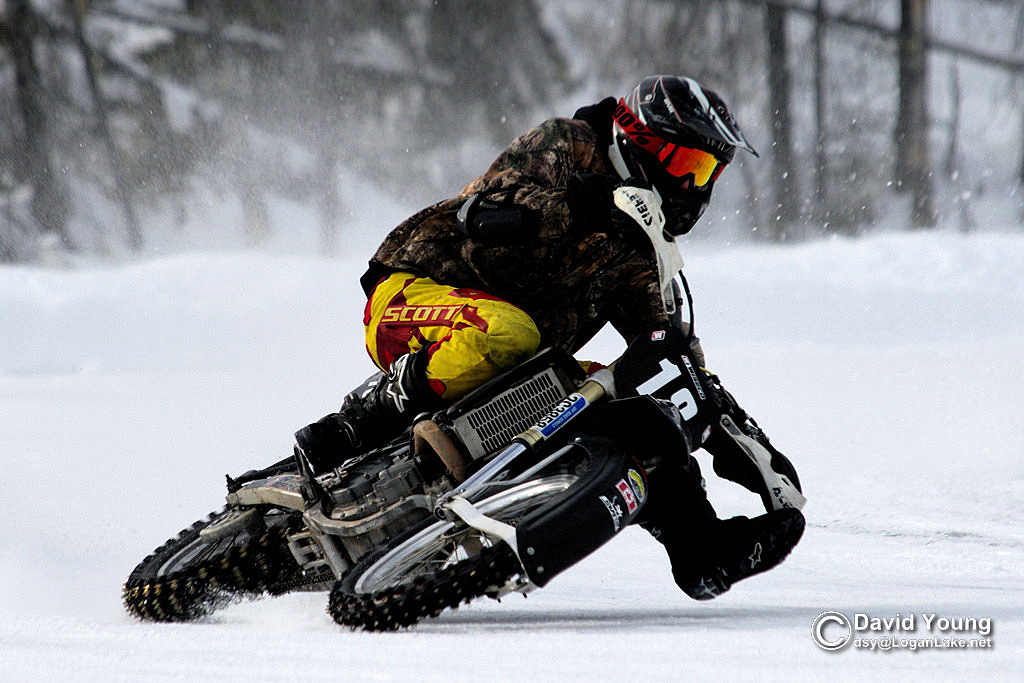 The rider (above) is not losing control - merely keeping his balance, while taking an icy corner at very high speed. Losing control looks like the two images below... 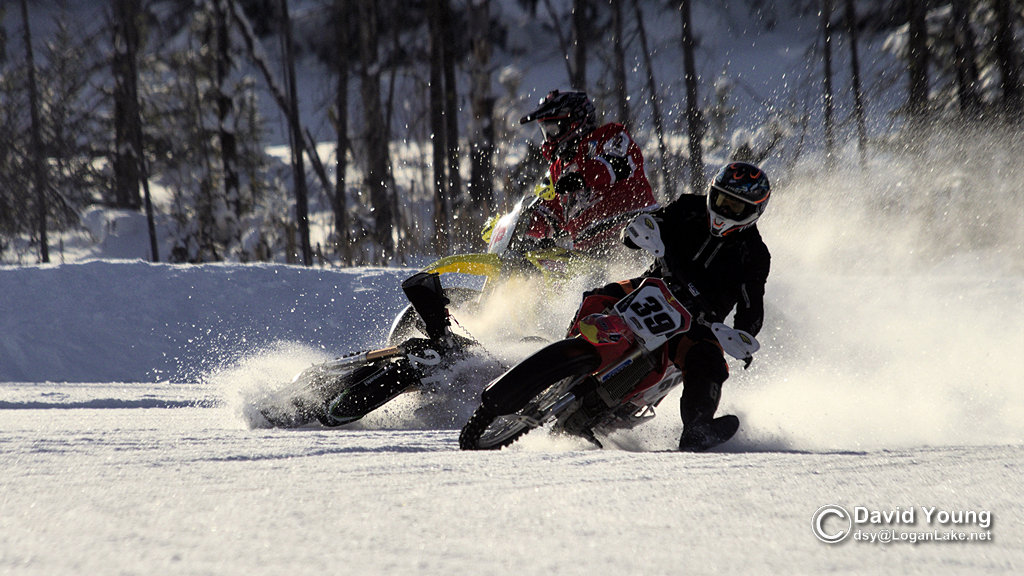 Both images were taken less than one second apart, in single-shot mode. 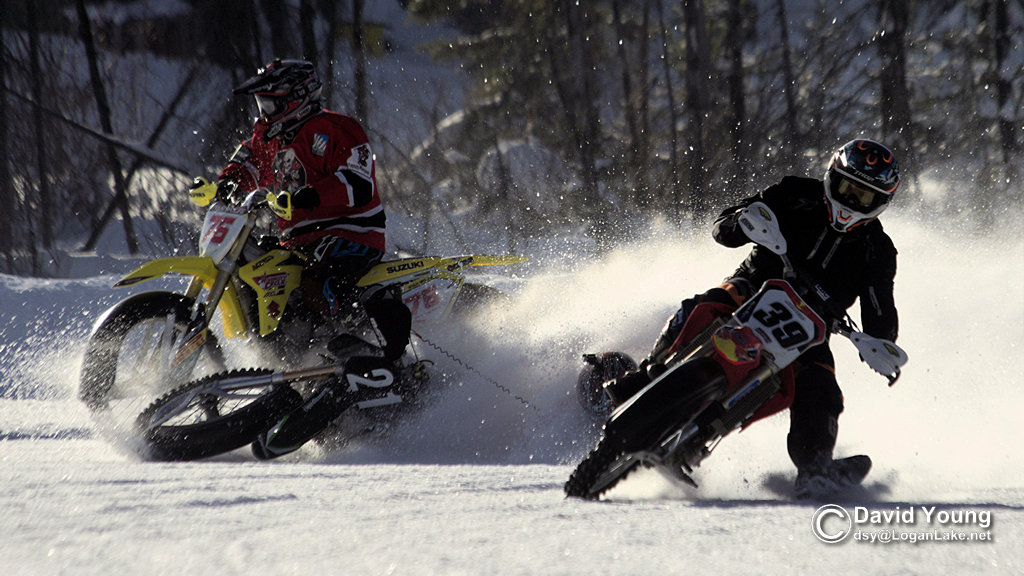 You can clearly see the coiled line to the "Kill Switch", which stops the bike's motor if the rider leaves his bike. Despite appearances, the #75 & #39 riders stayed upright, while the #21 rider was not hurt. 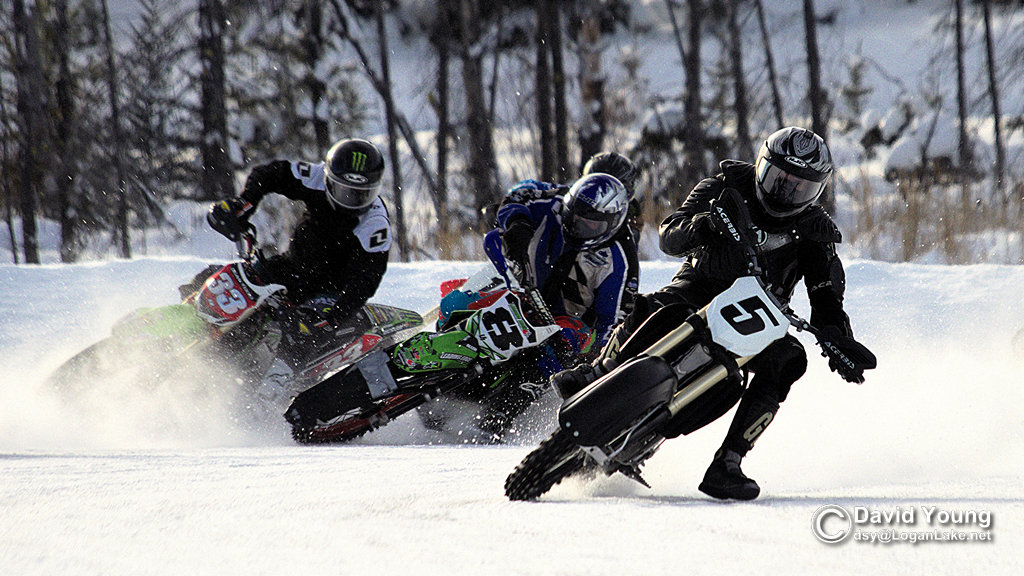 At 80 miles per hour (130kph), the tight formations of the riders can be quite risky. I tried shooting the Ice Racing with a friend's E-M5 and it's almost impossible without the phase detection AF. Shooting with the original E-M1 works, but with a high (almost 50%) failure rate. But, when it works, it's great! The key point of these examples is that, at least with AF tracking, in single-shot mode and with a 3x3 focus spot, the E-M1 Mk II almost never fails to caputure the shot! To show you just how well the camera can track fast moving objects, here is a series of 4 shots, taken one at a time, all within 1 second. This was a smaller bike, so likely going no more than 100 kph (62 mph). Each one looks tack sharp in a 12x18" print. 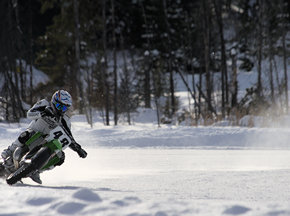 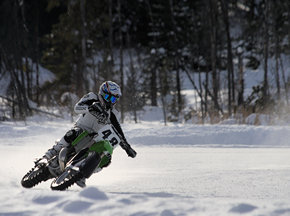 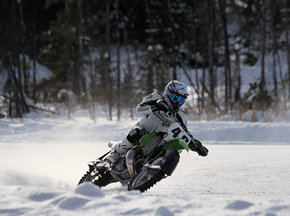 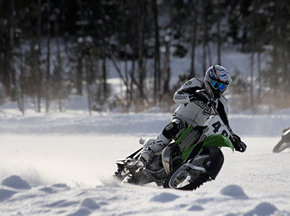 Method in my Madness... Many people have asked me, why I stick with the 50~200 f2.8-3.5 when the 40 to 150/4 is soooooo much nicer? I have to admit, the 40~150/4, is a sweet piece of kit. I've played with my buddie's copy and it's great! Certainly a much nicer "feel", than the 50~200/2.8-3.5 SWD. And I love the lens hood! But there are two good reasons for sticking with the old FT lens. First of all, it's effectively a 400, rather than a 300mm lens. I shoot wildlife and sports; and in both, "reach" is VERY important. With the 1.4x (which was used for all the shots above) it becomes a 560mm vs a 420 efl. Then there's the fact that it's a wee bit faster... up to a full stop, at the short end. But, the most important point is that I already own it and it's matching 1.4x! Cameras come and go ... new technology makes upgrading worthwhile, every second or third generation. But a good lens, if treated reasonably well, will last you a lifetime. My 50~200 SWD is now a decade old, and has been my main lenses for all those years. True, I had to send it in for repair after 9 years, to have it's weather sealing seals re-done (it siezed up, in the rain!), but it should be good for at least another 6 or 7 years. Some people say that the new lenses are sharper, with better resolution. That may be true. But when the first FT cameras came out, Olympus listed their resolution as exceeding that of a 20mp FT sensor. At the time, my E3 had just 10mp, so even with the losses introduced by the 1.4x there was no noticeable difference! Now, with the 20mp sensor in the EM-1 Mk II, I still see only a tiny bit of degredation when using the 1.4x. True, over time, mFT sensors may improve to 24 or even 30 megapixels, and by then I may have to buy a newer lens. But that is likely another 5 to 8 years away, and by then my 50~200 SWD will be pushing 20 years of hard, professional use. That's what I call "getting my money's worth!" Conclusion: The OM-D E-M1 Mark II (now that's a mouthful!) is solidly built, beautifully finished (almost to the standard of a Leica), lightweight and a thoroughly capable machine. Above all, the images it produces are up to top quality standards, suitable for almost any professional. As I mentioned, earliler, it is everything I'd hoped that the original OM-D would have been. Tracking high speed motorbikes, in freezing weather, it almost never failed. It's not expensive for a top-line camera, but it's not cheap, either. If it fits your budget, it will do almost anything you ask of it. UPDATE: In February of 2018, I sold my beloved 50~200/2.8-3.5 SWD Olympus Zoom, and my 400/6.8 Leitz Telyt, replacing them both with the new Leica 100~400 DG-Vario Elmar. I love it! It works beautifully (albeit with a few quirks) with the Olympus OM-D EM-1 MK II. The full report, if you're curious, is here. Last
updated: 25 February, 2018
Thanks for reading.
|
|||||||||||||||||
